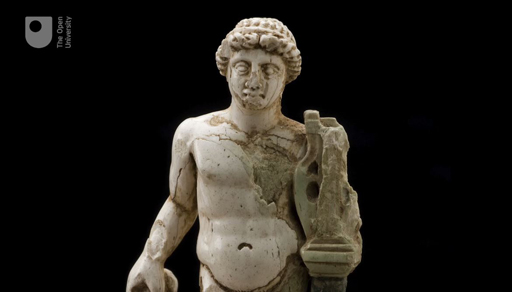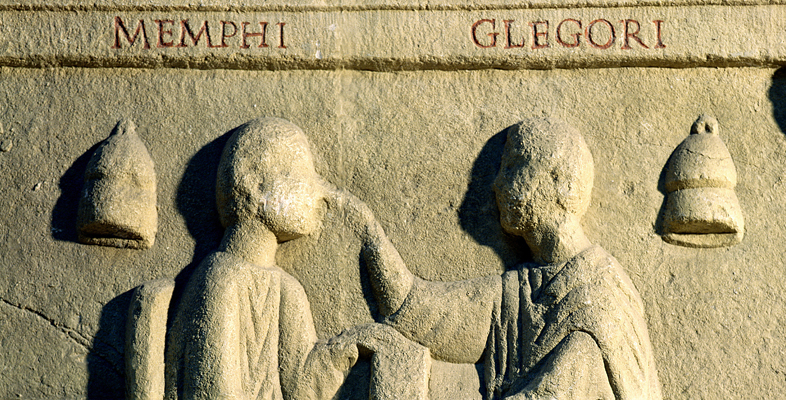1.5 Gifts for the gods: votive offerings
Why were images of parts of the body dedicated to the gods? In Video 2, Helen King talks to Dr Jessica Hughes of The Open University about how these dedications were used to preserve or encourage health.
Download this video clip.Video player: Video 2


Transcript: Video 2 Gifts for the gods: votive offerings
HELEN KING
Hello, I’m joined by one of my colleagues, Dr Jessica Hughes, also from the Classical Studies department.
JESSICA HUGHES
Hello.
HELEN KING
Can you just start by explaining to us what exactly a votive is?
JESSICA HUGHES
So, a votive offering is an object that people take to sanctuaries in the ancient world-- churches and temples today, as well. And it’s something that they offer to gods or saints, and it can be anything, really. It can be an object that they own. It can be a piece of their hair, or it can be a model of a body part.
HELEN KING
So what point do you give that thing to the god?
JESSICA HUGHES
Well, it’s very difficult to tell for certain in relation to our ancient objects, because we don’t have very many inscriptions on them. When we do find inscriptions, we find that they can be given as thank offerings after some kinds of miracle has been affected by the gods. Or perhaps they can be given as a request for some kinds of miracle or healing event. So both really. I think we have to keep very open minds when we approach the ancient evidence.
HELEN KING
So both before and after are possibilities.
JESSICA HUGHES
Yes.
HELEN KING
OK. So how widespread is the practise of giving these votives to the gods?
JESSICA HUGHES
I think it happens everywhere in the ancient world. Votive body parts, the models of parts of the human body, we find those all through Greece. We find them in Italy. We find them in the Western Empire, in Britain, in modern France, in modern Turkey, the Roman region of Asia Minor. They’re one of the most ubiquitous types of object that we find in the ancient world.
HELEN KING
Wow. So votives generally everywhere, and also votive body parts everywhere.
JESSICA HUGHES
Yeah, absolutely. And that goes for time as well. I mean, we find them as far back as the Minoan period, about 2000 BC. They occur in classical Greece, in the Roman Empire. And then again, the story can continue through the Middle Ages into the present day as well. So they really are everywhere.
HELEN KING
So which gods receive these votive body parts in particular? Are there particular gods associated with them?
JESSICA HUGHES
Any god could get a votive body part. There are some gods who seem to be particularly associated with them, like Asklepios, the god of healing. Apollo seems to get them quite a lot. But I think really any god could be approached for this kind of healing favour, if indeed, that’s what they are. We can think of somebody just going to their local sanctuary and asking their god or goddess if they could help them. Or they might make a special journey to a sanctuary that might have a particular reputation for healing some kind of body part.
HELEN KING
And are there particular body parts that are dedicated more than others?
JESSICA HUGHES
We find a really good range of body parts, and it depends a little bit on what region you’re looking at. Eyes are very common-- legs and arms. Other types of body part appear more in one geographical area than another. In Italy, we get lots and lots of internal body parts-- so things like wombs and livers. And those are completely absent in classical Greece. So you’ve got this very interesting situation where people in different regions are dedicating different types of body parts. And that must have really broad implications for how they’re understanding their body and how their bodies are working.
HELEN KING
Yeah. So what about the people who are doing this? Do we have any stories of people giving their body parts, or models of their body parts, to a god?
JESSICA HUGHES
It’s important to emphasise that most of the thousands of body parts that we have don’t come with stories attached. But in the region of Asia Minor, there are some really wonderful sculpted marble stelae, and these have images of body parts on. And they come with long inscriptions that show us that people in that area thought that they’d been punished in parts of their body. So it’s something that they’ve done wrong, generally a kind of sacred misdemeanour, something like going into the temple on the wrong day or stealing some of the god’s property.
So for example, there’s one that’s dedicated by a man called Diocles who’s ill in his eyes. It doesn’t go into much detail about the nature of the illness, but it does say on the inscription that he was punished by the god because he stole the god’s birds. And he was then erecting this stele as a way of accounting for his transgression, let’s say, in the hope of being healed. I mean, these are really amazing stories and I think they give insight into what the votives meant in that particular part of the ancient world. We can’t necessarily then extrapolate from that and say that’s what they meant everywhere.
HELEN KING
So let’s go back to that individual dedicant then. You turn up at a sanctuary. Have you brought a body part with you, or do you buy one there? How do you actually get a body part to dedicate to a god?
JESSICA HUGHES
There seems to be some evidence that body parts were on sale in sanctuaries, particularly in Italy. We find moulds, the evidence of some kind of craft industry. You also have to think that lots of the body parts would have been quite heavy, if you think of the big marble reliefs. That’s probably something that was bought on site.
Then again, there’s the possibility that the smaller body parts were brought with the dedicant. And I think if you think that long-term contact with the body of the dedicant, if you’ve got it in your pocket and you’re feeling it in your hands, I think that’s a really nice way of investing that object with something of yourself. So it might not represent your body as a kind of portrait, but the fact that you’ve been in contact with it for a long time means that it does belong to you in a way that it might not if you’ve just bought on site.
But again, I think the answer to your question is that it’s not going to be the same all over the ancient world. But in some sanctuaries, there may have been these shops where you went up and you picked your body parts and maybe then had it customised afterwards with paints. And then there might be people who bring things from home.
HELEN KING
I like the idea of it having to be in contact with your body. That somehow sort of helps it to be you for the god. Because that’s a bit like amulets that you wear close to your body. It’s fascinating. Now with amulets, they can be made of a range of different things. Is the same true for votives? What materials can they be made of?
JESSICA HUGHES
Absolutely it’s true. We have many in terra cotta and marble and bronze, and those are the materials that have survived. We also have some in wood, some from France in wood, and they’ve been preserved in waterlogged context. So that’s a bit of a happy accident of archaeology for us. But I think we need to think of votives in many different materials. So there may have been many more in wood that haven’t survived, because they’re not in quite such wet areas.
But also things like wax. Wax is very, very common in later periods. And if we are thinking about this idea of contact and representation of the body, I’d love to throw in this point about, in the Middle Ages and beyond-- in the Renaissance time as well-- that wax votives often weighed exactly the same as the parts that--
HELEN KING
Wow.
JESSICA HUGHES
Yeah. Or they were measured, and so your wax one was exactly the same size or it weighed the same as your child. So I think we have to be open to the possibility of wax as well, which of course wouldn’t have survived, but would have had its own very special symbolic resonances.
HELEN KING
That’s amazing. So as you say, it’s a tradition that continues through much of Western European history, and probably across the world, generally.
JESSICA HUGHES
Yes, we find it in many different religious contexts-- so in orthodox Greek faith, in Catholicism, in Buddhist temples as well. And for me, one of the most fascinating things about studying votives is this comparative element. So whether that’s within the ancient world, where you’re looking at differences between votives in Greece and Italy, or actually looking at differences across time or across different cultures and faiths, you know, what do people choose to represent, and how do they represent those body parts differently? And how does that tie into other sorts of discourse about the body in that faith? We look at hearts now in Christianity and think about the overlaps with the Sacred Heart of Jesus. I think it’s a very, very rich topic, and that’s partly thanks to the absolute ubiquity of votives and how they appear all over the place.
HELEN KING
Well, thank you. That’s an extremely rich account of votives and I think we’ve learned a lot there about ancient and modern, as well as about how the ancient world itself works. So thank you very much, Jessica.
JESSICA HUGHES
Thank you.
Video 2 Gifts for the gods: votive offerings
Interactive feature not available in single page view (see it in standard view).
Different amounts of body parts were found in different healing sanctuaries. In Athens, at the sanctuary of Asclepius, 40 per cent (154 objects) were eyes, while in Corinth limbs were more common. But did they only concern physical conditions or did they have a more complex meaning?
